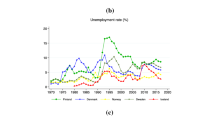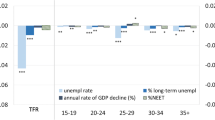Abstract
This paper analyses the fertility decline in Russia during theearly and mid 1990s from both a macro- and micro-perspective and presents astriking divergence between these two empirical viewpoints. While the formersuggests that the fertility decline after 1989 is associated with theeconomic hardship accompanying the transition to a market economy, themicro-evidence using the Russian Longitudinal Monitoring Survey is to thecontrary. There is no negative association between labour market uncertaintyor a labour market crisis and fertility, and frequently there is even apositive association. That is, women or couples who are themselves affectedby labour market crises often had a higher probability of having anotherchild in the period 1994–1996 than women/couples who were less affected bysuch crises. The lack of a negative association, and the presence of apositive association in many instances, is surprising from the standpoint ofeconomic fertility theory. It is also contrary to many explanatory theoriesabout the recent fertility decline in Central and Eastern European countriesthat are built on a more or less direct connection between the labour marketor an economic crisis and low fertility.
Similar content being viewed by others
References
Adler, M. A., 1997. 'Social change and declines in marriage and fertility in Eastern Germany'. Journal of Marriage and the Family 59(1): 37-49.
Ahn, N. and Mira, P., 2001. 'Job bust, baby bust: Evidence from Spanish data'. Journal of Population Economics 14(3): 505-522.
Andreev, E., Bondarskaya, G. and Harkova, T., 1998. padenie roschdaemosti v Rossij: gipotezi i fakti '[On fertility fall in Russia: hypotheses and facts]'. Voprosy Statistiki 10: 82-93.
Becker, G. S., 1981. A Treatise on the Family. Harvard University Press, Cambridge, MA.
Behrman, J. R., 1997. 'Intrahousehold distribution and the family', in M. R. Rosenzweig and O. Stark (eds), Handbook of Population and Family Economics. North Holland, Amsterdam, 125-188.
Bodrova, V., 1995. Reproductive behaviour of Russia's population in the transition period. Berichte des Bundesinstituts für Ostwissenschaftliche und Internationale Studien.
Bongaarts, J. and Feeney, G., 1998. 'On the quantum and tempo of fertility'. Population and Development Review 24(2): 271-291.
Brewster, K. L., 1994. 'Race differences in sexual activity among adolescent women: The role of neighborhood characteristics'. American Sociological Review 59: 408-424.
Brewster, K. L., Billy, J. O. G. and Grady, W. R., 1993. 'Social context and adolescent behaviour: The impact of community on the transition to sexual activity'. Social Forces 71(3): 713-740.
Brewster, K. L. and Rindfuss, R. R., 2000. 'Fertility and women's employment in industrialized nations'. Annual Review of Sociology 26: 271-296.
Chase, R. S., 1996. Baby boom or bust? Changing fertility in post-communist Czech Republic and Slovakia. Economic Growth Center Discussion Paper, No. 769.
Conrad, C., Lechner, M. and Werner, W., 1996. 'East German fertility after unification: Crisis or adaptation?'. Population and Development Review 22(2): 331-358.
Cornia, G. A. and Panicciá, R., 1996. 'The transition's population crisis: an econometric investigation of nuptiality, fertility and mortality in severely distressed economies'. MOCT- MOST 6(1): 95-125.
Council of Europe, 2000. Recent Demographic Developments in Europe. Council of Europe Publishing, Strasbourg.
Curtis, G. E., 1996. Russia: A Country Study. Federal Research Division, U.S. Library of Congress, Washington, D.C. (available at http://lcweb2.loc.gov/frd/cs/rutoc.html).
Eberstadt, N., 1994. 'Demographic shocks after communism: Eastern Germany 1989-1993'. Population and Development Review 20(1): 137-152.
Friedman, D., Hechter, M. and Kanazawa, S., 1994. 'A theory of the value of children'. Demography 31(3): 375-401.
Gustafsson, S. S., 2001. 'Optimal age at motherhood. Theoretical and empirical considerations on postponement of maternity in Europe'. Journal of Population Economics 14(2): 225-247.
Happel, S. K., Hill, J. K. and Low, S. A., 1984. 'An economic analysis of the timing of childbirth'. Population Studies 38: 299-311.
Heleniak, T., 1995. 'Economic transition and demographic change in Russia, 1989-1995'. Post-Soviet Geography 36(7): 446-58.
Hoem, B., 2000. 'Entry into motherhood in Sweden: The influence of economic factors on the rise and fall in fertility, 1986-1997'. Demographic Research [online available at http://www.demographic-research.org] 2(4).
Hotz, J. V., Klerman, J. A. and Willis, R. J., 1997. 'The economics of fertility in developed countries', in M. R. Rosenzweig and O. Stark (eds), Handbook of Population and Family Economics. North Holland, Amsterdam, 275-348.
Jimeno, J. F., Canto, O., Cardoso, A. R., Izquierdo, M., Rodrigues, C. F., Lokshin, M., Ravallion, M. and Luttmer, E. F. P., 2000. Making transition work for everyone: poverty and inequality in Europe and Central Asia. World Bank Working Paper # 20923.
Kohler, H.-P., 2000. 'Fertility decline as a coordination problem'. Journal of Development Economics 63(2): 231-263.
Kohler, H.-P., Billari, F. C. and Ortega, J. A., 2001. Towards a theory of lowest-low fertility. Max Planck Institute for Demographic Research, Rostock, Germany, Working Paper #2001-032 (available at http://www.demogr.mpg.de).
Kohler, H.-P. and Ortega, J. A., 2002a. 'Tempo-adjusted period parity progression measures, fertility postponement and completed cohort fertility'. Demographic Research [online available at http://www.demographic-research.org] 6(6): 91-144.
Kohler, H.-P. and Ortega, J. A., 2002b. 'Tempo-adjusted period parity progression measures: assessing the implications of delayed childbearing for cohort fertility in Sweden, the Netherlands and Spain'. Demographic Research [online available at http://www.demographic-research.org] 6(7): 145-190.
Kohler, H.-P. and Philipov, D., 2001. 'Variance effects in the Bongaarts-Feeney formula'. Demography 38(1): 1-16.
Kohlmann, A. and Zuev, S., 2001. Patterns of childbearing in Russia 1994-1998. Max Planck Institute for Demographic Research, Rostock, Germany, Working Paper #2001-018 (available at http://www.demogr.mpg.de).
Kreyenfeld, M., 2000. 'Changes in the timing of first birth in East Germany after re-unification'. Scholler's Jahrbuch - Zeitschrift für Wirtschafts-und Sozialwissenschaften 120(2): 169-186.
Kreyenfeld, M., 2002. Employment and fertility: East Germany in the 1990s. Doctoral Dissertation, University of Rostock and Max Planck Institute for Demographic Research, Rostock, Germany.
Lechner, M., 2001. 'The empirical analysis of East German fertility after unification: An update'. European Journal of Population 17(1): 61-73.
Lesthaeghe, R. and van de Kaa, D., 1986. 'Twee demografische transities?', in R. Lesthaeghe and D. van de Kaa (eds), Bevolking: Groei en Krimp. Van Loghum Slaterus, 9-24.
Lokshin, M. and Popkin, B., 1999. 'The emerging underclass in the Russian Federation: Income dynamics 1992-1996'. Economic Development and Cultural Change 47(4): 803-829.
Mroz, T. A. and Popkin, B. M., 1995. 'Poverty and the economic transition in the Russian Federation'. Economic Development and Cultural Change 44: 1-31.
OECD, 1995. OECD Economic Surveys: The Russian Federation 1995. Organisation for Economic Co-operation and Development.
Ott, N., 1992. Intrafamily Bargaining and Household Decisions. Springer Verlag, Berlin.
Philipov, D., 2001. Low fertility in Central and Eastern Europe: Culture or economy? Paper presented at the IUSSP Seminar on International Perspectives on Low Fertility: Trends, Theories and Policies. Tokyo, Japan, March 21-23.
Philipov, D. and Kohler, H.-P., 2001. 'Tempo effects in the fertility decline in Eastern Europe: Evidence from Bulgaria, the Czech Republic, Hungary, Poland, and Russia. European Journal of Population 17(1): 37-60.
Philipov, D. and Shkolnikov, V., 2001. Fertility intentions and coping strategies: Results from the 1998 round of the Russian longitudinal monitoring survey. Paper presented at the annual meeting of the Population Association of America, March 29-31, Washington D.C.
Rabusic, L., 1996. 'O soucasnem vyvoji manzelskeho a rodinneho chovani v Ceske Republice [On marriage and family trends in the Czech Republic in the mid-1990s]'. Demografie 38(3): 173-180.
Ranjan, P., 1999. 'Fertility behaviour under income uncertainty'. European Journal of Population 15(1): 25-43.
Rimashevskaya, N. M., 1997. 'Sotsial'nye posledstviya ekonomicheskikh transformatsii v Rossii [The social consequences of economic changes in Russia]'. Sotsiologicheskie Issledovaniya 6: 55-65.
Russian Longitudinal Monitoring Survey, 1998. RLMS project description: About the study. Survey documentation provided by the Carolina Population Center at the University of North Carolina at Chapel Hill. Online available at http://www.cpc.unc.edu/projects/rlms.
Rutkevich, M. N., 1996. 'Depopulyatsiya ili vymiranie? [Depopulation or extinction?]'. Sotsiologicheskie Issledovaniya 23(3): 104-110.
Sargent, T. J., 1993. Bounded Rationality in Macroeconomics. Oxford University Press, Oxford.
Scherbov, S. and van Vianen, H., 2001. 'Marriage and fertility in Russia of women born between 1900 and 1960: A cohort analysis'. European Journal of Population 17(3): 281-294.
van de Kaa, D. J., 1987. 'Europe's second demographic transition'. Population Bulletin 42(1): 1-59.
Vishnevsky, A. G., 1996. 'Family, fertility, and demographic dynamics in Russia: Analysis and forecast', in J. DaVanzo and G. Farnsworth (eds), Russia's Demographic 'Crisis'. RAND, Santa Monica, California, 1-35.
Witte, J. C. and Wagner, G. G., 1995. 'Declining fertility in East Germany after unification: A demographic response to socioeconomic change'. Population and Development Review 21(2): 387-397.
World Bank, 1998. Countries: Russian Federation. World Bank Country Brief.
World Bank, 2000. World Development Indicators. World Bank Publications, Washington, D.C.
World Health Organization, 1999. Health For All Data Base - European Region. World Health Organization, Kopenhagen, Denmark.
Zakharov, S. V., 1999. 'Fertility trends in Russia and the European New Independent States: Crisis or turning point?', in Population Division, United Nations (ed.), Population Bulletin, Special Issue Nos. 40/41 on 'Below Replacement Fertility'. United Nations, New York, 292-317.
Zakharov, S. V. and Ivanova, E. I., 1996. 'Fertility decline and recent changes in Russia: On the threshold of the second demographic transition', in J. Da Vanzo and G. Farnsworth (eds), Russia's Demographic Crisis. RAND Converence Proceeding, Santa Monica, 36-83.
Author information
Authors and Affiliations
Corresponding author
Rights and permissions
About this article
Cite this article
Kohler, HP., Kohler, I. Fertility Decline in Russia in the Early and Mid 1990s: The Role of Economic Uncertainty and Labour Market Crises. European Journal of Population 18, 233–262 (2002). https://doi.org/10.1023/A:1019701812709
Issue Date:
DOI: https://doi.org/10.1023/A:1019701812709




